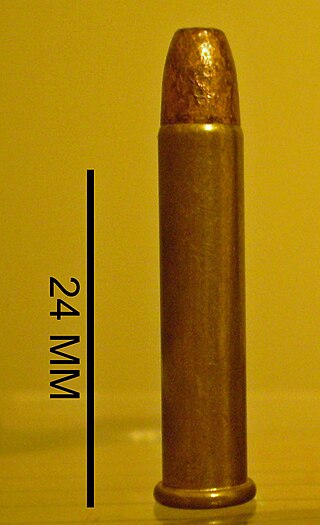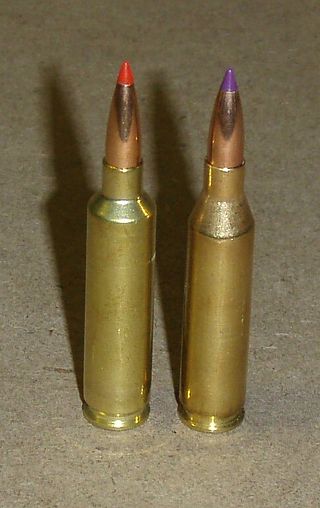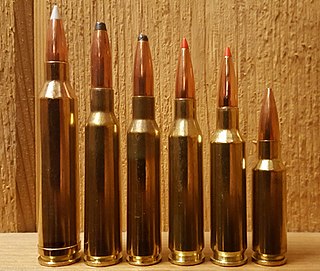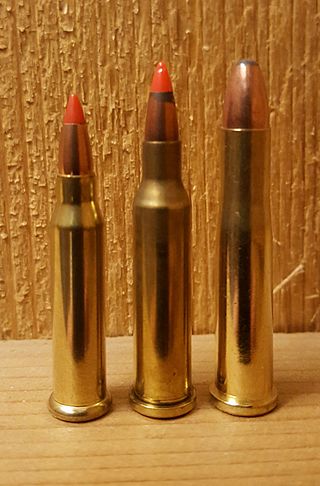
A rim-fire is a type of metallic cartridge used in firearms where the primer is located within a hollow circumferential rim protruding from the base of its casing. When fired, the gun's firing pin will strike and crush the rim against the edge of the barrel breech, sparking the primer compound within the rim, and in turn ignite the propellant within the case. Invented in 1845 by Louis-Nicolas Flobert, the first rimfire metallic cartridge was the .22 BB Cap cartridge, which consisted of a percussion cap with a bullet attached to the top. While many other different cartridge priming methods have been tried since the early 19th century, such as teat-fire and pinfire, only small caliber rimfire cartridges have survived to the present day with regular use. The .22 Long Rifle rimfire cartridge, introduced in 1887, is by far the most common ammunition found in the world today in terms of units manufactured and sold.

The .22 Long Rifle, also known as the .22LR or 5.6×15mmR, is a long-established variety of .22 caliber rimfire ammunition originating from the United States. It is used in a wide range of firearms including rifles, pistols, revolvers, and submachine guns.

The .22 Hornet or 5.6×36mmR Hornet is a varminting, small-game hunting, survival and competition centerfire rifle cartridge commercially introduced in 1930. It is considerably more powerful than the rimfire .22 WMR and the .17 HMR, achieving higher velocity with a bullet twice the weight of the .17 HMR bullet. The Hornet also differs significantly from these in that being a centerfire cartridge makes it reloadable, and thus more versatile. It was the smallest commercially available .22 caliber centerfire cartridge until the introduction of the FN 5.7×28mm.

The .22 Winchester Magnum Rimfire, also known as the .22 WMR, .22 Magnum, .22 WMRF, .22 MRF, or .22 Mag, is a rimfire cartridge. Originally loaded with a bullet weight of 40 grains (2.6 g) delivering velocities in the 2,000 feet per second (610 m/s) range from a rifle barrel, .22 WMR is now loaded with bullet weights ranging from 50 grains (3.2 g) at 1,530 feet per second (470 m/s) to 30 grains (1.9 g) at 2,200 feet per second (670 m/s).

A wildcat cartridge, often shortened to wildcat, is a custom cartridge for which ammunition and/or firearms are not mass-produced. These cartridges are often created in order to optimize a certain performance characteristic of an existing commercial cartridge, or may merely be intended as novelty items.

Sako Ltd is a Finnish firearm and ammunition manufacturer located in Riihimäki, Tavastia Proper in southern Finland. It also has owned the Tikka brand of bolt-action rifles since 1983, and is now owned by the Italian firearm holding company Beretta Holding. The name Sako comes from the company's former name Suojeluskuntain Ase- ja Konepaja Oy.

The .17 Hornady Mach 2, commonly known as the .17 HM2, is a rimfire cartridge introduced in 2004 by the ammunition manufacturer Hornady, following the successful launch in 2002 of the .17 HMR. The .17 HM2 is based on the .22 Long Rifle "Stinger" case, necked down to .17 caliber and using a bullet weighing less than half the weight of a typical .22 Long Rifle bullet.
The .204 Ruger is a centerfire rifle cartridge developed by Hornady and Ruger. At the time of its introduction in 2004, the .204 Ruger was the second-highest velocity commercially produced ammunition and the only centerfire cartridge produced commercially for bullets of .204 inch/5 mm caliber.
Hornady Manufacturing Company is an American manufacturer of ammunition cartridges, components and handloading equipments, based in Grand Island, Nebraska.
The Remington Model 597 is an American semi-automatic rifle that was manufactured by Remington Arms at the company's Mayfield, Kentucky and Huntsville, Alabama plant. The .22 Long Rifle version has a removable 10-round magazine, while the magazines for the larger .22 WMR and .17 HMR cartridges hold eight rounds.

.22 caliber, or 5.6 mm, refers to a common firearms bore diameter of 0.22 inch (5.6 mm) in both rimfire and centerfire cartridges.

The 5 mm Remington Rimfire Magnum or 5 mm RFM is a bottlenecked rimfire cartridge introduced by Remington Arms Company in 1969. Remington chambered it in a pair of bolt-action rifles, the Model 591 and Model 592, but this ammunition never became very popular, and the rifles were discontinued in 1974. About 52,000 rifles and 30,000 barrels for the T/C Contender pistol were sold during its brief production run. Remington discontinued the cartridge itself in 1982, leaving owners with no source of ammunition.
The .375 Ruger (9.5×65.5mm) is a rimless, standard-length rifle cartridge designed for hunting large, dangerous game. It is designed to provide an increase in performance over the .375 H&H cartridge within the context of a standard-length rifle action. The cartridge was designed in partnership by Hornady and Ruger. In 2007, it was released commercially and chambered in the Ruger Hawkeye African and the Ruger Hawkeye Alaskan rifles.

The .284 Winchester (7.21x55mmRB) is a rebated rim firearm cartridge, introduced by Winchester in 1963.

The 6.5mm Creedmoor (6.5×48mm), designated 6.5 Creedmoor by SAAMI, 6.5 Creedmoor by the C.I.P. or 6.5 CM or 6.5 CRDMR for short, is a centerfire rifle cartridge introduced by Hornady in 2007. It was developed by Hornady senior ballistics scientist Dave Emary in partnership with Dennis DeMille, the vice-president of product development at Creedmoor Sports, hence the name. The cartridge is a necked-down modification of the .30 Thompson Center.

A varmint rifle is a small-caliber precision firearm or high-powered airgun primarily used for both varmint hunting and pest control. These tasks include killing three types of pests or nuisance animals that spread diseases or destroy crops or livestock:
In firearms and artillery, the primer is the chemical and/or device responsible for initiating the propellant combustion that will propel the projectiles out of the gun barrel.

.17 Winchester Super Magnum, commonly known as the .17 WSM, is a rimfire rifle cartridge developed by the ammunition company Winchester in 2012. It descended from a .27 caliber nail-gun blank cartridge by necking down the blank case to take a .17 caliber (4.5mm) bullet. Initial loadings were with a 20 grains (1.3 g) bullet, delivering muzzle velocities around 3,000-foot-per-second (910 m/s).

















